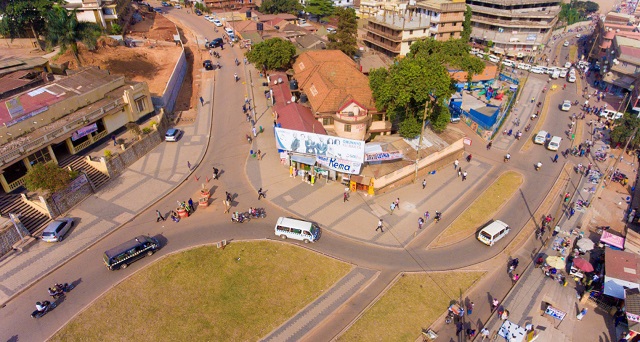
Anxious businesses
Everybody is anxious but not everyone is happy. As dust by the road construction workers billowed outside his shop on Luwum Street, Badru Kiberu, who sells watches, looked on sadly. He told The Independent that ever since the project started, business along the road has dwindled dramatically and traders continue to count losses.
“This project is good for pedestrians but not us,” he said.
He said business on Luwum Street came mainly from car driving shoppers who prefer to park and shop and not the hordes of traders that crowd the Kikuubo and Namirembe section that KCCA appears to be targeting.
“Most of our customers used to be people who don’t want to go downtown but want to make a brief stop near our shops, buy a shirt or watch and go away,” he told The Independent. He does not see customers returning even after the opening of the ‘pedestrian shopping street’ – because cars will no longer be allowed in.
His neighbour, Brenda, a dealer in wedding clothes, says the project has ruined her.
“Customers cannot come here anymore because the city has a problem of parking space,” she said, “For pedestrians, it is okay but for customers who come to specifically buy stuff here, it is difficult.”
But when The Independent spoke to KCCA officials about the worried traders, they said the traders will come to love the project when it is completed this March.
The KCCA Executive Director Andrew Kitaka told The Independent on Feb. 14 that “by March 2020, residents of Kampala will enjoy shopping without worrying about speeding bodas and taxis.”
“And we are certain businesses will record high sales with more people shopping,” he said.
He said the authority chose this stretch because it is a high-density pedestrian area but it lacked designated space for people to walk and shop.
“Shopping along this corridor was unpleasant and as a result, businesses lost out on potential customers, as many opted not to shop in this unsafe environment.” Kitaka said, “This will change soon.”
In a recent post on KCCA’s Facebook page, Kitaka said Kampala borrowed the design from cities like Jerusalem in Israel where part of the city’s business district was redesigned in 2011 to only be accessible by light rail. No cars are allowed in the redesigned area and the number of shoppers increased because it was more accessible, and the shopping experience more pleasant.
Kitaka says even in Jerusalem, business owners had earlier objected to the project during the construction phase but realized unmatched profits and they are big supporters of pedestrian shopping streets.
“The business community should not worry that this will negatively affect their business. Actually, it will enhance their business through reduction of congestion, improved safety/security for all and creation of easier access to the area for pedestrians.”
Peter Kaujju, the KCCA publicist told The Independent on Feb. 14 that the authority is certain there is going to be more traffic of pedestrians along the redesigned route and traders will get more business. Instead, Kaujju says, KCCA is more concerned about the street furniture, street lights, benches, flowers and grass being installed.
“We appeal to business owners, customers, vendors and city residents to support the initiative and protect them all,” he said.
KCCA says a road user satisfaction survey published by the Uganda Road Fund in October last year noted how construction of designated walkways topped the priorities that pedestrians wanted in the city. It was ahead of other priorities like fixing potholes (12%), dust control (11%), construction of more pedestrian crossings (8%) and better road designs (6%).
Happy cyclists
Amanda Ngabirano, a cycling enthusiast and lecturer of urban and regional planning in the Department of Architecture and Physical Planning at Makerere University says she is happy that KCCA has finally come up with a project that targets the majority of city residents.
Ngabirano told The Independent that for this project to succeed there is need for sensitization of the residents so they change their behaviour when it comes to road usage.
“This should be the responsibility of KCCA but also the Traffic Police will have to come in and enforce the regulations,” she said.
Ngabirano wishes KCCA could fast-track the extension plan so that the entire city can have the same network she sees along this stretch.
She says a network that, for instance, makes it easy to walk or cycle from Kalerwe to Old Kampala unhindered would go a long way in making life easier for Kampala’s pedestrians and cyclists.
Charles Waako, a bodaboda cyclist thinks this is positive development for Kampala city which should be embraced by everyone. His only worry also is that the demarcation of the roads for motorists, cyclists and pedestrians might not work unless KCCA sensitizes first and then tries to enforce the laws.
Waako says Ugandans always behave like they are in a hurry.
“I will not be surprised to find bodaboda cyclists in the pedestrian section and pedestrians in the section for the motorcycles,” he said. But KCCA says route guides and traffic signage will be displayed at junctions and all across the route. The authority says it intends to work with its enforcement team and the police to ensure businesses operate smoothly and in accordance with set regulations.
Non-motorized transport includes all forms of movement that do not rely on an engine for mobility. It is recognized as a valuable component of the transport system and the environment due to the various benefits it holds.
Kampala’s aim is to join cities that are realizing the benefits of non-motorized transport and are designing policies, programmes and projects to accommodate non-motorized transport needs.
The city authority says it is also planning to work with a vendor to provide bicycles or scooters for hire along this corridor, which has special bicycle lanes.
Kitaka said successful implementation of the non-motorized pilot project will de-congest this part of the city and lead to wider coverage of the city with such routes in future.
“In addition, walking and cycling are beneficial to the population and have been proved to be an effective control of non-communicable diseases,” he says.
Motorized transport is associated with high fuel prices, air pollution, and traffic congestion which force the government to invest in correcting the damage; including the high environmental impact costs. Cycling and walking, meanwhile, enhance mobility options, offer green transport, and boost the economy. That is the dream KCCA wants to become reality in Kampala.
****
 The Independent Uganda: You get the Truth we Pay the Price
The Independent Uganda: You get the Truth we Pay the Price




A failed tv personality turned urban planner spends a few days in Europe and enjoys the experience of riding a bicycle in the middle of European city and returns home and wants to do same in stereotypical African city regardless of culture misfit and the negative social and economic impact and anyway her wishes are quickly and easily granted..and be damned the hapless entrepreneurs and others whose livelihoods will be ruined by this sillyness .
If non motorised transport corridors are good why not start with planting flowers and allowing only pedestrians on the Jinja road-kampala road- bombo road corridor. Even better why not experiment this in places like kololo, bugolobi, nakasero, naguru were the obese residents would generally benefit from the forced walking.
Money wasted on this hairbrained scheme would have been better spent on the million-challenges Kampala faces such as:
– Repairing the potholed roads of the city
-Improving tarmac coverage from the lowly 500km.
-Providing street lights in the mostly dark streets of Kampala more so the business areas like kikuubo,Nasser road to encourage development of a night economy.
-Upgrading of slums thru constructing of affordable public housing for Kampala’s urban poor.
-And the list could on and on and still wouldnt include this non-motorised-transport scheme for self indulgent “elites”
Well, sincerely, the Namirembe Road – Luwum Street corridor has for so long been the “most walked” or one of the “most walked” corridors in Kampala, with such huge volumes of pedestrians.
Driving there has always been a nightmare and the pedestrians in that part of town include those whose means of transport is walking as well as those who can’t risk driving in that section of town.
This NMT corridor, in my opinion, is one of the few projects in Kampala that have been inspired by a need: the need to ensure that walking is made easier and safer in an area where walking is the biggest means of transport.
All the things you mention are important and sure need to be done but not at the expense of a safe non motorised space.
Great piece, Ronald!
“Urban planning to favour the majority who either walk or cycle.” is an excellent idea on every continent. It is certainly not silliness that will ruin livelihoods. Every city where the transition towards friendlier streets has started, soon sees the benefits are much bigger than disadvantages are. People get healthier and happier, streets are less congested, social live improves and road safety improves. These changes support each other and create a spiral towards a successful city. Healthy happy people are more productive and active children perform better at school. Kampala’s urban poor do not profit from motorized transport Walking and cycling are not for the self indulgent elites, they are for everybody.
Cities in Europe are the first to embrace cycling as an important form of transport, but experts agree that the model is the answer to many problems in every urban area. All over the world city policy makers are becoming aware of the fact that the classic ‘motorized’ city is just not sustainable. Lately I see more news from Africa on the subject and that is very good. Walking and cycling have a positive social and economic impact.
Culture misfit does not exist. Culture is something that always keeps changing, just like language. If it wouldn’t be like that, there wouldn’t even be a single car in Kampala. They would have never been accepted. 100 years ago there were no cars at all in Kampala.
(I am the founder of group on Facebook callen Bicycle world and publish about cycling news every day)
Thank you, Auke van Andel!
Wow wow,I I’ve the fact that the city is really decongested and urban mobility is being appreciated especially by pedestrians.
However,I don’t know what you HV in mind for the rotational movements from and to the taxi parks especially the old park,there seems to be a lot of frustration.
Other wise, well done.